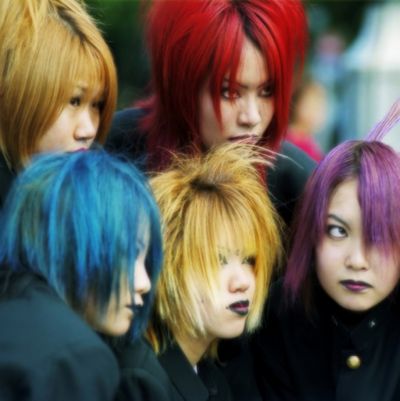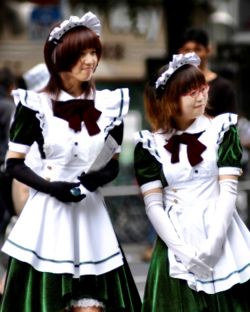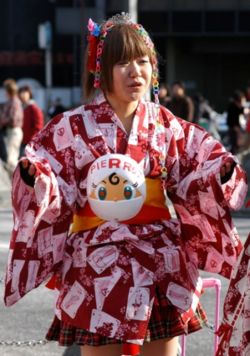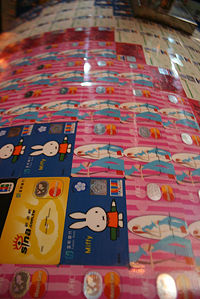Japanese popular culture

Photo © by Sonny Santos, used by permission.
Japanese popular culture is a highly distinct collection of fashions, art, music and other forms of expression, appearing in both mainstream society and underground subcultures. While some examples of these are widely known in the West, such as cinema's Godzilla monster, many today are either unique to Japan or mainly influence contemporary Asian popular culture.
Popular culture in Japan is very much the mainstream; while ancient sites are easy to find, the Japanese are rarely seen practising traditional arts such as ikebana (活花, 'flower arranging'). Cartoons, comics and above all, anything kawaii (可愛い, 'cute') are strong influences on high-tech products and clothes available in the high street, as well as teenage and children's fashions. While young Japanese often follow overseas trends, they have also developed their own trendy subcultures that to outsiders may border on the bizarre - young people dressed in maid outfits or in cute Victorian-style 'Lolita' costumes are more common a sight in Tokyo than traditionally-dressed maiko (妓) girls in historic Kyoto. These trends come and go, reported by the huge media industry, find a home in the more seedy areas of Japanese society, and are taken to extremes by enthusiasts known as otaku (おたく).
Cuteness
Much of mainstream Japanese society conforms to the idea that goods and lifestyle decisions should be kawaii (可愛い, 'cute'). Baby-faced cartoons such as Pokémon (ポケットモンスター, Poketto Monsutaa 'Pocket Monster') and small gadgets, often pink, are perhaps the best examples of this phenomenon, which is thought to be rooted in the rise of a Japanese consumer society in the 1970s, and also through the encouragement of dependent social relationships and the need to escape a highly stratified society.[1] Many adults adore cuteness as much as children and teenagers: for example, bank cards are available with cute cartoon characters printed on them, and though the culture of kawaii is most firmly established among young girls, grown men are prepared to be seen with cute items too. The prevalence of kawaii has led to criticism both within and outside Japan, depicting its society as one of increasing infantilisation; such goods tend to be popular with non-Japanese children but have yet to make inroads among foreign adults.[2] To a greater or lesser extent, each of the themes discussed below involves an appreciation of cuteness in some way.
Media
Japan is a nation of avid newspaper and magazine readers. About 92% of households subscribe to a morning newspaper, and the Japanese apparently consider print media to be the most reliable way to get their news. Newspaper circulation is significantly ahead of other nations,[3] News reporting ranges from serious political stories to the latest celebrity gossip, detailed in popular magazines as well as on-line. Newspapers and the government often make use of comics (manga, 漫画 'comic') to put across important issues to people of all ages.[4] The biggest-selling newspapers are the right-wing Yomiuri Shimbun (読売新聞) and the left-leaning Asahi Shimbun (朝日新聞),[5] while one of most widely read magazines is FRUiTS, a monthly guide to street fashion.[6]
'Idols'
Japanese media extensively covers celebrity news, particularly the activities of aidoru (アイドル, 'idol'). Typically well-promoted female singers or bit-part actors distinct from other 'talents', their media lives are often short-lived, usually because they are selected mainly for their youth and cute looks rather than obvious ability. While occasionally idols such as Aya Sugimoto (杉本彩, Sugimoto Aya) continue to appear in the press for some time, often due to controversies in their personal lives, a few of them stay around long enough to influence a new fashion or craze, and even go on to become mainstream performers. For example, the singer Kumi Koda (倖田來未, Kooda Kumi), who has enjoyed success in the music charts for several years, is also associated with the fashion for hot pants, and the singer and actress Kyoko Koizumi (小泉今日子, Koizumi Kyooko) has been around in a variety of guises since the heyday of idols in the 1980s.[7]
Manga
One of the most popular forms of entertainment in Japan is manga (漫画; in hiragan まんが; in katakana マンガ), meaning print 'comics' or 'cartoons'; [8][9] Manga are immensely popular in Japan[10][11] and, in the past two decades, have become popular worldwide, with the word now firmly established in the English language to refer to these.
Typically, manga are printed in black and white, and as is the case with much other Japanese reading matter, are read from right to left, starting from the 'back' of the book. They cover a wide variety of topics, from adventure, romance, and horror to sports, science fiction, and explicit sexuality.[9][12][13][14] Drawing styles vary considerably, from intricate and complex page layouts to simple line drawings.[9][12] Manga stories cover all kinds of adventures, with four creations particularly well-known: the robot-child Astro Boy (or Mighty Atom, i.e. 鉄腕アトム Tetsuwan Atomu); the independently-minded lady Sazae-san (サザエさん); the time-travelling mechanical cat Doraemon (ドラえもん); and Black Jack (ブラック・ジャック), the tale of an underworld surgeon who performs implausible operations to save the innocent. The artist Osamu Tezuka (手塚 治虫 Tezuka Osamu) became known as the 'God of Manga' for giving the world Astro Boy in 1952,[15] and was also responsible for developing Black Jack in the 1970s. Doraemon has been thrilling readers since 1969, and these adventures have been the recipient of several awards, including Asahi Shimbun's 'Tezuka Osamu Cultural Prize' (手塚治虫文化賞, Tezuka Osamu Bunkashō) in 1997. The cat was also recognised by Time Asia magazine in 2006 as an 'Asian Hero', or cultural icon.[16]
Manga are typically published first in magazines and then in paperback books called 単行本 tankoobon, and, if popular enough, then animated.[17] Manga also serve as an interesting way of getting the news: government ministries as well as corporations have often used manga to put across complicated ideas to the public.[18]
In Japan, manga are read by people of all ages, and fans can be seen reading their favourite stories in 24-hour convenience stores or with coffee in special round-the-clock 'manga cafés' (漫画喫茶 or マンガ喫茶, manga kissa). Another place to find the legions of manga readers is at the three-day 'Comic Market' (コミック・マーケット Komikku Māketto) in Tokyo, Japan's largest public indoor gathering; at this magazine fair a vast number of manga are available to browse and buy.[19]
Artists outside Japan have adopted many manga techniques.[20] Manga-influenced comics include not only work by US artists,[21] but also Korean manhwa[22] and Chinese manhua[23][24] as well as "la nouvelle manga" by Frédèric Boilet and his collaborators.[25] Since May 2007, the Japanese Ministry of Foreign Affairs has recognised excellence for non-Japanese manga in its annual International Manga Award.[26]
Film, television and video games
Television
A wide variety of television programmes are broadcast around the clock in Japan, and in many ways a typical line-up of programmes consists of just what a viewer would expect: regular news bulletins, documentaries, films, and light entertainment such as quiz shows. What makes Japanese television stand out, perhaps, is the appearance of many programmes and the work of those who appear on-camera: entertainment programmes in particular will typically make use of flashy graphics and cute animations, as is also often the case on websites, not just in Japan but in East Asia generally. Furthermore, a succession of personalities appear on Japanese television whose behaviour can often be described as rather bizarre.
The main broadcaster is NHK (日本放送協会 Nippon Hoosoo Kyookai 'Japanese Broadcasting Corporation'), a public body funded through a television licence, which runs two national terrestrial channels alongside its satellite, radio and internet services. NHK's output is supplemented by various other regional television stations. Foreign output includes Hollywood movies and popular South Korean soap operas.
Entertainment
Television entertainment mainly consists of drama, comedy series and quiz shows. Drama is a staple of Japanese television; NHK's historical drama series Taiga Dorama (大河ドラマ) has become a national institution since it began in 1963 as a televised kabuki (歌舞伎)[27] play. Other series are contemporary, such as many 'trendy dramas' (トレンディドラマ Torendi Dorama) that tackle issues such as teenage pregnancy, homosexuality and gender identity disorder.
Television celebrities regularly appear on the nation's TV screens. One kind of celebrity is generally famous for their own personalities rather than their work: tarento (タレント) or 'talents' may become famous for a particular gimmick or act in often short-spanned careers, while others might become known through a drama series or sporting activity. They are often distinct from 'idols', as their fame is based on some kind of ability rather than looks alone.
Video games
Pokémon
Anime
Technology
Internet
Virtual characters
Robots
Purikura
Purikura (プリクラ) is an example of wasei-eigo (和製英語 'made-in-Japan English'), short for purinto kurabu (プリント倶楽部) - i.e. 'print club'. However, it refers to special photo booths, sometimes incorporating a full-length self-service studio, where participants have their photographs taken against a screen (usually while striking various poses, to the accompaniment of trendy background music) before filling in patterns, objects, drawings and so on electronically via a keyboard or electronic pen. The results are printed out and can be downloaded into a mobile phone or sent to an email address. Purikura has been popular in Japan for several years; booths are often found in amusement arcades and are a draw mainly for the younger generations.
Going out

Photo © by Sonny Santos, used by permission.
'Water trade'
Hostess bars
Karaoke
Pachinko
Theme parks
Fashion and subcultures

Photo © by Sonny Santos, used by permission.
Otaku
Otaku (おたく) is Japanese slang for obsessive enthusiasts of some pastime. In English, this particularly means manga, anime or video games, but in Japan one can be an otaku of just about anything. Otaku as an identity or art form has started to mainstream in recent years, with otaku art such as the Warhol-esque work of Takashi Murakami (村上隆 Murakami Takeshi); however, the word still holds negative connotations for many, and may conjure up an image of an inward-looking 'geek' who rarely leaves home.
Cosplayers
Crazes
Office workers
Relationships
Love hotels
Gay Japan
Sex industry
Soaplands
Enjo koosai
Footnotes
- ↑ Garger (2007).
- ↑ e.g. Kerr (2002:312).
- ↑ Yomiuri Shimbun (2008): 'Japanese newspapers have stable readership'.
- ↑ See Kinsella (2000) and the manga section of this article.
- ↑ See Yomiuri Shimbun (2008), above.
- ↑ STREET/FRUiTS/TUNE - official English website.
- ↑ Internet Movie Database: 'Kyôko Koizumi'.
- ↑ Lent (2001).
- ↑ 9.0 9.1 9.2 Schodt (1986).
- ↑ Schodt (1986), op. cit., Chapter 1, pp. 12-27.
- ↑ Thorn, Matt 29th September 2008. 'Just how much do those Japanese read manga?' http://matt-thorn.com/wordpress/?p=261 ; 'More stats on manga reading in Japan'. http://matt-thorn.com/wordpress/?p=272 Accessed 3rd October, 2008.
- ↑ 12.0 12.1 Gravett (2004: 8).
- ↑ Masanao (2004).
- ↑ Koyama-Richard (2007).
- ↑ Schodt (2007).
- ↑ Time Asia: 'The Cuddliest Hero in Asia'. 2006.
- ↑ Kinsella (2000).
- ↑ For a controversial example of the use of manga to explain defence policy, see Mainichi Daily News: 'Defense Ministry turns to 'Lolita' manga character to reveal inner self'. 24th July 2007.
- ↑ Comiket.co.jp: 'What is the Comic Market?'. Official information from the organising committee.
- ↑ Tai, Elizabeth. 23rd September 2007. The Star Online: 'Manga outside Japan'. http://thestar.com.my/lifestyle/story.asp?file=/2007/9/23/lifebookshelf/18898783&sec=lifebookshelf Accessed 3rd October 2008.
- ↑ Cha, Kai-Ming and Calvin Reid, 17th October 2005. Publishers Weekly: 'Manga in English: Born in the USA'. http://www.publishersweekly.com/article/CA6272269.html Accessed 3rd October 2008.
- ↑ Japan Times: 'Manga by any other name is...'. 28th May 2006.
- ↑ Wong (2002).
- ↑ Wong (2006).
- ↑ Boilet (2003).
- ↑ MOFA: First International MANGA Award. http://www.mofa.go.jp/announce/announce/2007/6/1174276_828.html Accessed 3rd October 2008.
- ↑ Traditional Japanese theatre.

